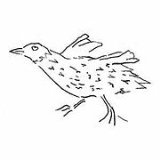
Ascension Flightless Crake
Encyclopedia
The Ascension Crake is an extinct flightless bird that previously lived on Ascension Island
in the South Atlantic Ocean. It was declared extinct by Groombridge in 1994; BirdLife International
confirmed this in 2000 and 2004. It is a member of the family Rallidae
.
The bird was endemic to Ascension Island. Numerous subfossil bones of the bird have been found; Peter Mundy
made a sketch of it in 1656. It most likely lived in the near-desert areas of the island and primarily ate Sooty Tern
(Sterna fuscata) eggs. It is probable that it became extinct after rats were introduced to the island in the 18th century, but it may have survived until the introduction of feral cats in 1815.
The bird was regarded by Storrs Olson as a relative of Atlantisia rogersi, but recent analysis (Bourne et al., 2003) has shown that the differences between the two are greater than previously appreciated. The new genus Mundia (named after the discoverer Peter Mundy) was created in 2003.
Ascension Island
Ascension Island is an isolated volcanic island in the equatorial waters of the South Atlantic Ocean, around from the coast of Africa and from the coast of South America, which is roughly midway between the horn of South America and Africa...
in the South Atlantic Ocean. It was declared extinct by Groombridge in 1994; BirdLife International
BirdLife International
BirdLife International is a global Partnership of conservation organisations that strives to conserve birds, their habitats and global biodiversity, working with people towards sustainability in the use of natural resources...
confirmed this in 2000 and 2004. It is a member of the family Rallidae
Rallidae
The rails, or Rallidae, are a large cosmopolitan family of small to medium-sized birds. The family exhibits considerable diversity and the family also includes the crakes, coots, and gallinules...
.
The bird was endemic to Ascension Island. Numerous subfossil bones of the bird have been found; Peter Mundy
Peter Mundy
-Life:He came from Penryn in Cornwall. In 1609 he accompanied his father to Rouen, and was then sent to Gascony to learn French. In May 1611 he went as a cabin-boy in a merchant ship, and gradually rose in life until he became of independent circumstances....
made a sketch of it in 1656. It most likely lived in the near-desert areas of the island and primarily ate Sooty Tern
Sooty Tern
The Sooty Tern, Onychoprion fuscatus , is a seabird of the tern family . It is a bird of the tropical oceans, breeding on islands throughout the equatorial zone. Colloquially, it is known as the Wideawake Tern or just wideawake...
(Sterna fuscata) eggs. It is probable that it became extinct after rats were introduced to the island in the 18th century, but it may have survived until the introduction of feral cats in 1815.
The bird was regarded by Storrs Olson as a relative of Atlantisia rogersi, but recent analysis (Bourne et al., 2003) has shown that the differences between the two are greater than previously appreciated. The new genus Mundia (named after the discoverer Peter Mundy) was created in 2003.

